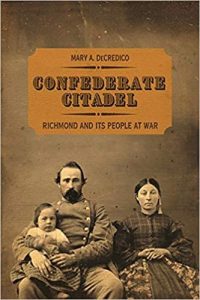Book Review: Confederate Citadel
 Confederate Citadel:
Confederate Citadel:
Richmond and Its People at War
By Mary A. DeCredico
University Press of Kentucky, 2020, $50 hardcover
Reviewed by Stephen Davis
The bookshelf devoted to the Confederate capital is a considerable one, beginning with Sallie Putnam’s Richmond During the War (1867). Its traditional anchors include Alfred Hoyt Bill, The Beleaguered City (1946) and Emory M. Thomas, The Confederate State of Richmond (1971)—and that’s not counting works on the fall of the city in ’65 (Patrick, 1960; Hoehling, 1971; Lankford, 2002).
The continued vitality of the topic is further demonstrated by recent works: Mike Wright, City Under Siege: Richmond in the Civil War (1995), Ernest B. Furgurson, Ashes of Glory: Richmond at War (1996) and Steven V. Ash, Rebel Richmond: Life and Death in the Confederate Capital (2019).
So the question may fairly be asked: is there room for yet another Richmond war-book? Yes, if its author is a trained historian, skillful researcher and talented narrator. Mary DeCredico is a history professor at Annapolis. For this book she has trawled through numerous manuscript collections, published diaries and memoirs, plus a lot of secondary sources. All of this is evident in fifty pages of notes and bibliography—a quarter of the book.
Richmond in 1860 was the South’s second largest city, with a thriving community of merchants, bankers and manufacturers. Five railroads fanned out. More than half of the city’s industry was devoted to tobacco and flour. Founded in 1837, Tredegar made Richmond a major producer of iron goods as well; the mill was the largest in the South. Sixty-nine slave trading businesses sold blacks to Deep South plantations. All of this made a lot of people rich; in 1860 Richmond had a per capita wealth higher than New York and Boston.
As the Confederacy’s most industrial city and capital of its most populous state, Richmond was the new nation’s logical choice for its seat of government. The administration waited until Virginians had voted, on May 23, to approve secession. Within a week President Davis and his wife were checked into the Spotswood Hotel.
With commendable economy of verbiage—her narrative encompasses just 151 pages—DeCredico traces Richmonders’ war experiences: development as hospital center after Manassas; encounters with food shortages and inflated prices; the flight of citizens at McClellan’s approach; the overflow of burials in Oakwood Cemetery. The city’s population swelled to more than 70,000 by the end of ’62 (double the number in 1860). Housing became both dearthy and dear.
The Richmond Bread Riot of April 1863 is well known; DeCredico adds colorful details. Six weeks later, Jackson’s body lay in state at the capitol. Interlaced in her narrative are lively quotes from manuscript repositories and standard sources. After Gettysburg Josiah Gorgas wondered, “Can we believe in the justice of Providence, or must we conclude that we are after all wrong?”
Major campaigns such as the Seven Days are highlighted without laborious militrivia. At the same time, DeCredico’s work is a city history, not a military one. Thus in the summer of 1864 its eyes are on food shortages, “general debauchery,” prostitution and robberies. Sheridan’s ravaging of the Valley exacerbated the prevailing hunger. As the ANV clung to the Petersburg trenches, Richmonders were quite aware, as one put it in February 1865, that “the Yankees are closing in on us.” When word came, April 2, that Lee was giving up the capital, Davis and government officials hastily packed what they could and boarded trains for Danville. Citizens scrambled for conveyances to flee. After Confederates put the torch to tobacco warehouses, the flames spread fast. Magazine explosions rocked the city. Amidst the chaos came the looting. Whiskey barrels were broken into; people drank it from gutters. Slave traders set their property free; soldiers and slaves alike could be seen drunk and reeling.
Soon Federal troops marched in and raised the United States flag. A mortified Myrta Lockett Avary framed the situation for many a Richmonder: “Was it to this end we had fought and starved and gone naked and cold? To this end that the wives and children and many a dear and gallant friend were husbandless and fatherless? To this end that our homes were in ruins, our state devastated?”

Great review. Convinced me to get a copy. Loved your word multiracial. Never heard it before Plan to use it with your permission. Keep up the great work!
word is militrivial not multiracial
So, here is my problem, Mr. Davis. I already have some of the Richmond books you mention in this nice review. There are of course essays about life in Richmond elsewhere in works such as the 5-volume Virginia at War series by the same publisher, University of Kentucky, which I have. From your review, I don’t see anything particularly new in this book. The fact that the author may tell the same story in a more compelling way than other authors is not likely to move me to buy a $50.00 book going over the same ground. There is a limit to the space on my already overflowing bookshelves!